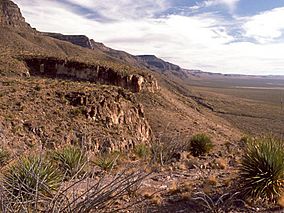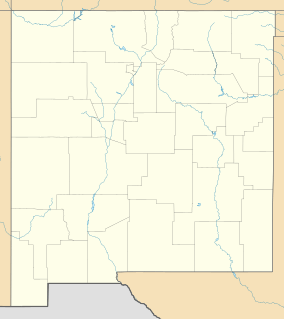Oliver Lee Memorial State Park facts for kids
Quick facts for kids Oliver Lee Memorial State Park |
|
|---|---|

The western escarpment of the Sacramento Mountains, looking south at sunset from the Dog Canyon Trail
|
|
| Location | Otero County, New Mexico, |
| Area | 640 acres (260 ha) |
| Elevation | 4,363 ft (1,330 m) |
| Established | 1980 |
| Named for | Oliver Lee |
| Governing body | New Mexico State Parks Division |
| Website | Oliver Lee Memorial State Park |
Oliver Lee Memorial State Park is a special state park in New Mexico, United States. It protects a beautiful canyon in the Sacramento Mountains. The park also preserves the old ranch house of Oliver Lee from the 1800s.
This park covers about 640 acres and sits at an elevation of 4,363 feet. It's located at the bottom of Dog Canyon. Here, you can enjoy camping, hiking, and picnicking. It's also a great place to see wildlife. There's a nature trail and even tours of the historic ranch house.
The Dog Canyon National Recreational Trail climbs up the mountainside. From the top, you get amazing views of the Tularosa Basin and the Organ Mountains. The city of Alamogordo and White Sands National Park are close by. Oliver Lee Memorial State Park first opened in 1980.
Contents
Park History and People
Oliver Lee Memorial State Park is made of two separate areas. Both parts have a rich history. The Dog Canyon area was once used by Apache warriors. They used it as a strong defensive spot during their battles with early explorers and settlers.
Oliver Lee built his home near the entrance of Dog Canyon in 1893. His ranch is now a historic site. It shows what a ranch home looked like when Lee lived there. Lee was a well-known rancher in the area.
Native American Life
Oliver Lee Memorial State Park is in the Chihuahuan Desert. This part of New Mexico gets very little rain, only about 11.6 inches each year. But Dog Canyon has a stream that flows all year long. This made it a very important place for Native Americans to live and travel through the Tularosa Basin.
The first people known to live here were the Paleoindians. They lived in the area from about 9500 BC to 5500 BC. They hunted large animals that are now extinct, like Mammoths and huge bison. We know they were here from the spear points and old campsites found in the park.
Later, people from the Archaic period lived here from 5500 BC to 200 AD. These people stayed in one place more than the Paleoindians. They hunted animals and gathered plants for food. After them came the Jornada Mogollon peoples (200 - 1400 AD). They were farmers who lived in villages. They grew crops using both dry-land and flood-land agriculture. Archaeologists have found tools, pottery, and pueblo ruins from the Jornada Mogollons. They also found rock art.
By 1400, the Mescalero Apache became the main tribe in the Tularosa Basin. They were a mobile tribe, meaning they moved around a lot. They lived in tipis and found their food by hunting and gathering. They left behind tools like spear points, drills, and stone axes. These Apache were the people that Spanish explorers and later American settlers met. The Apache fiercely protected their lands from newcomers.
Early Settlers and the Ranch
Over time, the Apache were forced from their lands by the United States military. The Oliver Lee Memorial State Park area saw many fights between the Apache and Anglo-Americans. These conflicts happened from 1848 until 1912 during the Apache Wars. Many battles took place right inside Dog Canyon.
The first settler to build a home here was Francois Jean Rochas in 1885. He built a two-room house made of rock and adobe at the mouth of Dog Canyon. Rochas planted an orchard and built retaining walls on the canyon ridges. You can see a partly rebuilt cabin where his home once stood near the park's visitor center.
Oliver Milton Lee arrived in the area in 1893 from Buffalo Gap, Texas. He started a 320-acre ranch just south of Dog Canyon. Lee built a ranch house, barns, and corrals. He also created an irrigation system to bring water from the canyon stream to his ranch. You can still see parts of this water system in the park today. Oliver Lee continued to run his ranches until he passed away in 1941.
Lee sold his ranch in 1907. After a few different owners, the ranch lands became part of the White Sands National Monument in 1939. In 1983, the 440-acre Dog Canyon area was given to the State Parks Division. The southern part of the park was transferred to New Mexico in 1998.
Park Geology
Oliver Lee Memorial State Park is at the base of the western escarpment of the Sacramento Mountains. It includes Dog Canyon and the land north of it. A stream flows through the canyon all year, which is very rare in the Chihuahuan Desert.
The Sacramento Mountains are a large mountain range east of Alamogordo. They stretch for about 85 miles north to south. Dog Canyon is one of many canyons on the west side of these mountains. The canyon walls show the park's long geologic history. This history goes back from 570 million years ago (the Ordovician period) to 300 million years ago (the Permian period).
Evidence of ancient sea life shows that this land was once covered by a shallow sea. The rocks here contain fossils of creatures like nautiloid cephalopods. Native Americans used a type of rock called chert, left behind by the receding seas, to make stone tools. Rocks from the Mississippian age show old ocean floor deposits. They also contain fossilized remains of crinoids and bryozoans.
About 30 million years ago, the Sacramentos experienced a volcanic time. Volcanic forces pushed igneous rock into older rocks from the Devonian Period.
Oliver Lee Memorial State Park is on the edge of the Tularosa Basin. This basin is a closed basin, meaning no streams flow out of it. Any surface water that doesn't evaporate or soak into the ground collects in temporary intermittent lakes. The basin covers about 6,500 square miles. It formed 25 million years ago when faults caused the surrounding mountains to rise and the basin to sink.
Dog Canyon was carved by strong flows of water and earth from the mountains. Heavy rocks and fast-moving water shaped the canyon over millions of years. Lake Otero formed from heavy snowmelt and rains about 20,000 years ago. As temperatures rose, Lake Otero began to dry up. Parts of this ancient lake can still be seen today in Lake Lucero and the gypsum dunes of White Sands National Park.
Water, Plants, and Animals
Water is super important in the Chihuahuan Desert. The stream in Dog Canyon creates a special riparian environment in Oliver Lee Memorial State Park. This is unique for the area. The stream keeps flowing from rain and melting snow. Water also seeps up from natural springs in the park's limestone. The stream dries up just west of the park, and the rest of the water flows underground. It supports small insects and amphibians, but no fish.
Plants of the Park
Trees found along the stream include Rio Grande cottonwood (Populus deltoides wislizeni), New Mexico locust (Robinia neomexicana), and velvet ash (Fraxinus velutina). Away from the stream, you can find one-seeded juniper (Juniperus monosperma), desert willow (Chilopsis linearis), and netleaf hackberry (Celtis reticulata).
Shrubs in the park include four-wind saltbush (Atriplex canescens) and creosote bush (Larrea tridentata). Wild grapes (Vitis arizonica) and western poison ivy (Toxicodendron rydbergii) grow in the cooler, wetter parts of Dog Canyon.
Many types of cacti also grow here. These include strawberry hedgehog (Echinocereus fendleri), cane cholla (Opuntia imbricata), and many prickly pears (Opuntia spp.). Water plants like cattail (Typha angustifolia), giant helleborine (Epipactis gigantea), and maidenhair fern (Adiantum capillus-veneris) thrive near the stream. The park staff can provide a list of all the plants found here.
Animals of the Park
Oliver Lee Memorial State Park is home to many mammals common in the upper Chihuahuan Desert. These include collared peccary (a type of wild pig), ground squirrels, mule deer, black-tailed jackrabbits, and desert cottontails. These animals are prey for larger predators.
Predators you might find are American black bears, cougars (also called mountain lions), and bobcats. Other animals include American badgers, North American porcupines, raccoons, White-nosed coatis, and several types of bats and skunks.
Two kinds of rattlesnakes live in the park: the western diamondback and the black-tail. You can also find several types of lizards, skinks, geckos, turtles, and non-venomous snakes. The Texas horned lizard, which is rare in some places, is doing well in the park. These horned lizards are protected by law in the park and all of New Mexico.
Amphibians like salamanders and toads are also found here. The park is a home for many birds too. These include turkey vultures, red-tailed hawks, mourning doves, hummingbirds, warblers, and wrens.
Fun Activities
Oliver Lee Memorial State Park is open all year for fun activities! You can go hiking, camping, picnicking, and watch for wildlife.
There are two main trails in the park. The Dog Canyon Trail starts at the visitor center. It climbs up the canyon walls for 5.5 miles and goes up 3,144 feet. At the top, the trail enters the nearby Lincoln National Forest. There's also an interpretive trail near the visitor center. This trail lets you explore the green area along the stream in the canyon.
The park has 44 campsites, and 16 of them have electric hookups for RVs. Picnic areas are available in different spots throughout the park, perfect for a meal outdoors.


